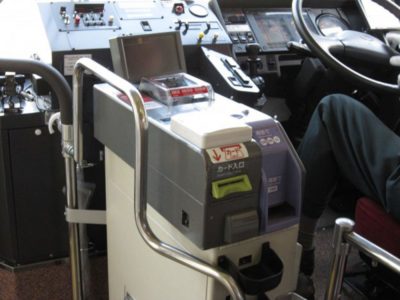In most cities in Japan, it is normal to use the extensive train and subway network system. It’s a great way to move from one place to another quickly and conveniently. But in the case of Japan’s ancient capital Kyoto, the best way to get around is by bus. This is because in many cases the train stations are located a long walk from the attractions that tourists want to see. Let us explain how to use the bus system, so you are well-prepared for your trip to Kyoto!

Kyoto City Bus
The buses from Kyoto City Bus have a light green color. They also have a number on the front that indicates the direction you are going. If the number has a blue background and the numbers are white it means that it is within the area of flat prices. That is, on buses that have this design the adult ticket will cost 230 yen and the children’s ticket will cost 120 yen. It will be this price, no matter where you get on or off. Buses that have another type of design on the screen where the number is shown have a different price depending on where you want to go.
Are you planning to take the bus at least 3 times in one day? Then it is recommended to buy the One-day Pass for 600 yen per person. With this pass, you can take all flat-fee buses as many times as you want. The flat-fee buses cover a wide range of attractions all over the city. So it is a good investment if you want to do a lot of sightseeing. This pass can be obtained at the Kyoto Bus Information Center outside the north exit of Kyoto Station, or on the bus itself.
Raku Bus for Tourists
There is also a tourist bus service called Raku Bus with a flat rate of 230 yen per ride. These buses have bright colors and are designed specifically for tourists, so they only stop at tourist sites. The announcements are made in English and other languages, as well as in Japanese. There are 3 Raku buses:
Raku Bus 100: departs from Kyoto station every 10 minutes between 7:40 and 17:00. Follow the following route: Kyoto Station – National Museum and Sanjusangendo Temple – Kiyomizudera Temple – Gion – Heian-jingu Shrine – Ginkakuji Temple
Raku Bus 101: departs from Kyoto station every 15 minutes between 8:00 AM and 4:30 PM. Follow the following route: Kyoto Station – Nijo-jo Castle – Kitano Tenmangu Shrine – Kinkakuji Temple – Daitokuji Temple – Kitaoji Bus Terminal.
Raku Bus 102: leaves the Ginkakuji-michi bus stop every 30 minutes between 8:04 and 16:34. Follow the following route: Ginkakuji Temple – Kyoto Imperial Palace – Kitano Tenmangu Shrine – Kinkakuji Temple – Daitokuji Temple – Kitaoji Bus Terminal.
How To Ride the Kyoto Bus
You get on the bus via the back door, and you exit the bus at the front door where the driver is. The bus must be paid with the exact amount in coins, and although next to the slot to insert the money there is a machine that changes coins and bills of 1000 yen, it is recommended to have the exact amount ready when getting off because normally buses are crowded and it is not advisable to obstruct the passage of other passengers. IC cards can also be used on these buses instead of cash, making payments much faster and more efficient.
To request a stop, you just have to press one of the stop buttons. Kyoto buses have a screen in front showing which station you are leaving and what the route will be. In this way, there should be no confusion regarding when to press the stop button.
The buses are narrow and most do not have space to carry large suitcases, therefore, it is recommended not to travel on buses with large luggage but take a taxi instead.
Your Japan Tour
If you want to travel worry-free and follow your expert guide on the train, bus, or private bus, contact us to start planning your unforgettable holiday to this fascinating country full of once-in-a-lifetime experiences, culture, history, nature, and delicious food!